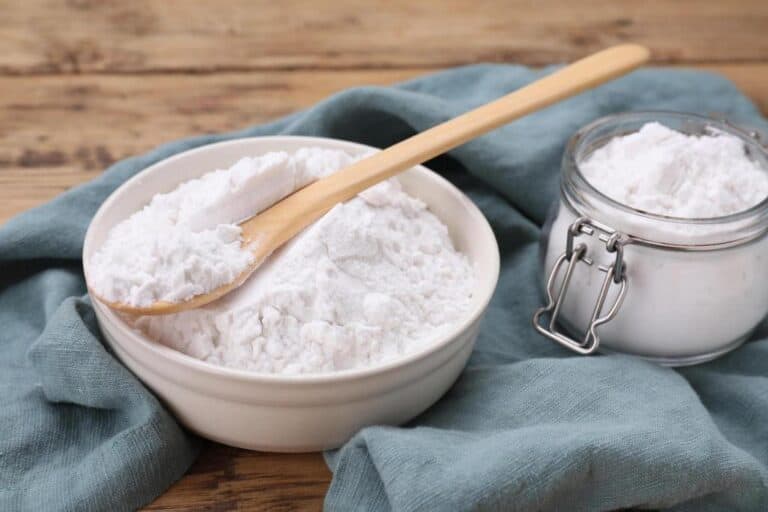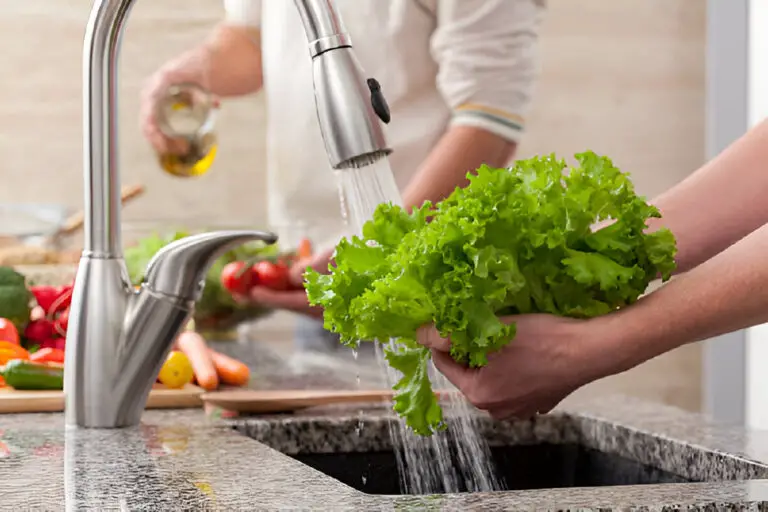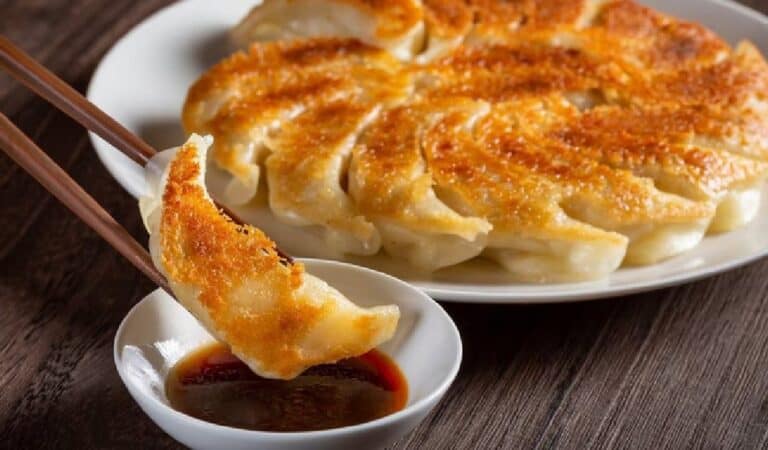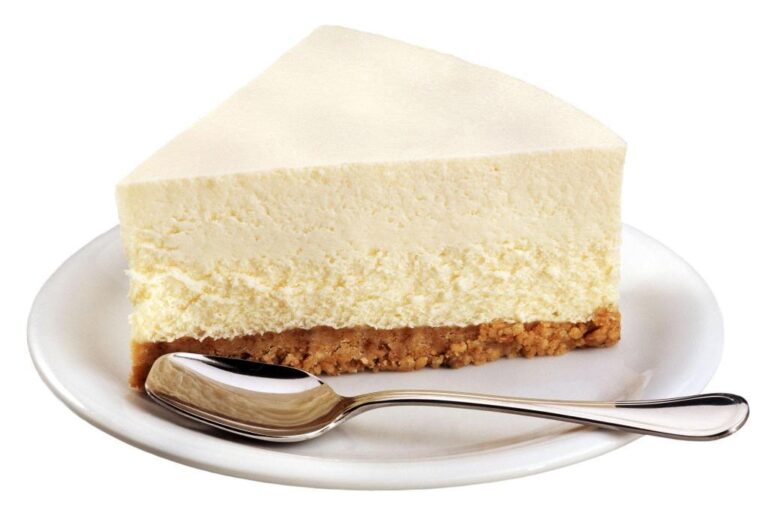Can You Cook Gyoza in Olive Oil? Healthier Cooking, Delicious Results

Gyoza is a well-liked dish all over the world. It is filled with savory ingredients. They are made by first pan-frying them in vegetable oil until they are crispy and golden-brown. Then, they are steamed to ensure the filling is perfectly cooked.
However, as culinary experimentation knows no bounds, an intriguing question arises: Can you cook gyoza in olive oil? Using this rich and flavorful oil to add its taste to the dumplings is a great idea. It opens up many culinary possibilities.
Join us to explore adding olive oil to this classic dish. We’ll see if it can make gyoza more delicious.
Benefits of Using Olive Oil for Gyoza

When it comes to crafting the perfect gyoza, olive oil emerges as a surprising yet beneficial ingredient in the cooking process. This Mediterranean gem brings with it a myriad of health benefits that can elevate your gyoza game.
Olive oil is famous for its heart-healthy fats, polyphenols, and antioxidants. It is a healthier choice than traditional oils. Using olive oil in cooking gyoza adds wholesomeness to your dish. It also nurtures your body with every flavorful bite.
Moreover, the use of olive oil goes beyond just health considerations; it can significantly enhance the flavors of the gyoza filling. The fruity and grassy notes of olive oil are unique. They can complement traditional ingredients like minced pork, cabbage, and garlic. Other oils may not do this.
You might drizzle extra-virgin olive oil over your dumplings before cooking. Or, you might infuse it into the filling. This versatile ingredient could revolutionize how you make this beloved dish.
Next time you reach for the pan to cook gyoza, consider reaching for that bottle of olive oil. It might be the secret ingredient you’ve been missing!
Traditional Cooking Methods for Gyoza
In traditional ways of making gyoza, oils like sesame oil or vegetable oil are often used. These oils have been long-standing staples in Asian cuisine, known for imparting unique flavors and textures to the dish.
People commonly use vegetable oil for pan-frying gyoza. It has a neutral taste and a high smoke point. It gives gyoza a crisp and golden-brown outside that many gyoza enthusiasts love. On the other hand, sesame oil brings a distinct nutty aroma to the gyoza, adding depth to the overall flavor profile.
One concern some may have when considering using olive oil for cooking gyoza is the potential alteration of the authentic taste. Gyoza purists argue that deviating from traditional oils could change the familiar flavor they know and love. The fruitiness and grassy notes of olive oil might seem odd in Asian cuisine. This is because vegetable and sesame oils are more common there.
But, as foods change and chefs keep experimenting with ingredients, olive oil has found its way into many cuisines worldwide. This includes Japanese-inspired dishes like gyoza.
Can You Cook Gyoza in Olive Oil?
Yes, you can cook gyoza dumplings in olive oil, and it can be a healthier option compared to other cooking oils. Pan-frying gyoza dumplings with olive oil is a simple process that requires only olive oil, water, a non-stick pan, and a lid.
To cook gyoza dumplings in olive oil, start by heating a non-stick pan over medium-high heat and adding a small amount of olive oil. Place the gyoza dumplings in the pan, ensuring they are not overcrowded. Allow the dumplings to cook for a few minutes until the bottoms are lightly browned.
Next, add water to the pan, just enough to cover the bottom. Immediately cover the pan with a lid to trap the steam. Allow the dumplings to steam in the pan for about 5-7 minutes, or until the water has evaporated and the dumplings are cooked through.
Remove the lid and let any remaining water evaporate. Continue cooking the dumplings for another minute or two, or until the bottoms are crispy and golden brown. Serve the gyoza dumplings hot, and enjoy their delicious flavor and crispy texture!
Comparing Cooking Gyoza Dumpling: Olive Oil vs. Traditional Oils
The oil you choose matters a lot when cooking gyoza dumplings. It affects their texture, flavor, and quality. Many people use olive oil for many dishes. But, it may not be best for cooking gyoza. This is because it has a lower smoke point and can smoke or burn at high temperatures. People often prefer traditional oils like peanut, canola, and corn oil for frying and cooking. This is due to their higher smoke points. These points allow for safer and more efficient heating.
For crispier dumplings, some cooks recommend using a neutral oil like canola or grapeseed. This can help achieve a better crust without overpowering the dumpling’s flavor.
Sesame oil is flavorful. But, it’s not usually used for frying. This is because it has a high smoke point and may add a strong flavor that does not complement the dumpling’s taste.
In terms of the cultural significance of olive oil and sesame oil, they play important roles in different cuisines and traditions.
Olive oil is deeply rooted in Mediterranean cuisine and is often used as a finishing touch to enhance the flavor of dishes. Sesame oil, on the other hand, is commonly used in Asian cuisines and is valued for its nutty flavor and health benefits.
When choosing an oil for cooking gyoza, you must consider the oil’s smoke point and flavor. Also consider the texture and taste of the final product. While olive oil can be a great choice for many dishes, it may not be the best option for cooking gyoza due to its lower smoke point. People often prefer traditional oils like peanut, canola, and corn oil for frying and cooking. This is due to their high smoke points and neutral flavors.
How to Pan Fry Gyoza Dumplings in Olive Oil?
Pan-frying gyoza dumplings in olive oil is a simple and delicious way to cook them. Here’s how to do it:
- Prepare the Gyoza: If using frozen gyoza dumplings, make sure to thaw them completely before cooking. If you’re using homemade or fresh gyoza, they’re ready to cook.
- Heat Olive Oil: In a large non-stick pan, heat a small amount of olive oil over medium-high heat. Make sure the oil is hot but not smoking.
- Add Gyoza to the Pan: Carefully place the gyoza dumplings in the hot oil, making sure they are not overcrowded. You may need to cook them in batches, depending on the size of your pan.
- Pan Fry the Gyoza: Allow the gyoza to cook for 2-3 minutes, or until the bottoms are golden brown and crispy. Avoid moving them around too much to ensure a crispy crust forms.
- Add Water and Cover: Carefully add a small amount of water to the pan, just enough to cover the bottom. Immediately cover the pan with a lid to trap the steam.
- Steam the Gyoza: Let the gyoza steam for 5-7 minutes, or until the water has evaporated and the dumplings are cooked through.
- Finish Cooking: Remove the lid and let any remaining water evaporate. Continue cooking the gyoza for another minute or two, or until they are crispy on the bottom and fully cooked.
- Serve: Transfer the cooked gyoza to a plate and serve them hot with your favorite dipping sauce. Enjoy the crispy texture and delicious flavor of the pan-fried gyoza dumplings!
| Also read: How to Cook Gyoza Dumpling and Rice Together in a Rice Cooker |
What Is the Cooking Time Needed to Pan Fry Gyoza Dumplings in Olive Oil?
The cooking time to pan-fry gyoza dumplings in olive oil can vary. It depends on factors like the heat level, wrapper thickness, and if the dumplings are fresh or frozen. Generally, it takes about 5 minutes to pan-fry the gyoza until the bottoms are golden brown and crispy.
After pan-frying, add water to the pan and steam the gyoza for 5-7 minutes. Do so until the water has evaporated and the dumplings are cooked. Overall, you can expect the total cooking time for pan-frying and steaming gyoza dumplings in olive oil to be around 7-10 minutes.
Ingredients to Pan Fry Gyoza Dumplings in Olive Oil
In order to pan fry gyoza dumplings using olive oil and get amazing and super delicious, and tasty gyoza dumplings, you will just need the following simple ingredients:
- Gyoza Dumplings: Use store-bought or homemade gyoza dumplings. Make sure they are thawed completely if using frozen dumplings.
- Olive Oil: Use a good quality olive oil for pan-frying. Olive oil adds a delicious flavor to the dumplings and is a healthier option compared to other cooking oils.
- Water: You’ll need water to create steam in the pan to cook the dumplings. Use enough water to cover the bottom of the pan.
Optional ingredients for serving:
- Dipping Sauce: Prepare a dipping sauce for the gyoza using soy sauce, rice vinegar, sesame oil, and a pinch of sugar. You can also add grated ginger or garlic for extra flavor.
- Toppings: Toppings are important. Add chopped green onions, sesame seeds, or furikake (Japanese seasoning) to the cooked gyoza. They add flavor and texture.
- These simple ingredients are all you need to pan-fry gyoza dumplings in olive oil and enjoy a delicious and satisfying meal.
Conclusion: The Perfect Pairing of Gyoza and Olive Oil
In conclusion, our culinary exploration sheds light on the potential of olive oil in perfecting your gyoza. Not only does olive oil offer health benefits, but it can also enhance the flavors of your gyoza fillings in ways traditional oils may not. By experimenting with different oils, home cooks and food enthusiasts alike have the opportunity to elevate their gyoza-making experience.
As you embark on your own gyoza-making journey, don’t hesitate to try out various oils to find what suits your palate best. You can stick with tradition or choose olive oil. But, remember, the key to delicious gyoza is the care and creativity you put into each fold.






